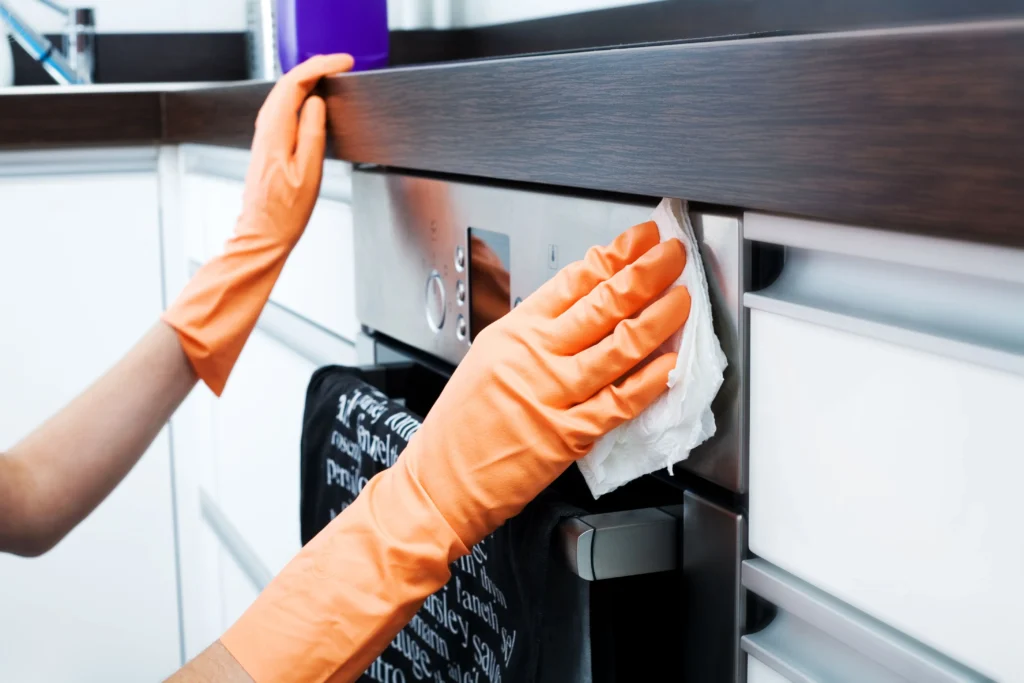How to Clean Stainless Steel Appliances
Have you been searching for ways to clean your stainless steel recently? Do you want to know the steps and procedures needed to clean your stainless steel? Here, you will get to know all the necessary steps needed to clean and maintain your stainless steel.

Maintaining the shining appearance of stainless steel can be a bit challenging due to its susceptibility to fingerprints and streaks. To effectively clean stainless steel, it’s crucial to wipe in one consistent direction, following the grain.
If you’re uncertain about the direction, start in a small area and observe the results. From our research, we’ve found that a clean microfiber cloth is highly effective, but you can also opt for paper towels.
It’s essential to note that there are various types of stainless steel, so some experimentation may be needed to determine the best cleaning approach for your specific appliance. Different stainless-steel appliances might require slightly different cleaning methods to achieve the desired shine.
How to Clean Stainless Steel Appliances
Stainless steel appliances and items are known for their sleek and modern look, but keeping them clean and shiny without using harsh chemicals is a concern for many.
Here are some effective methods to clean stainless steel without resorting to chemicals:
1. Wipe With a Damp Cloth
When it comes to cleaning stainless steel without the use of chemicals, starting with a simple wipe-down can work wonders. All you need for this method is a clean cloth or a microfiber towel and some hot water. Much like wood, stainless steel possesses a grain. To effectively clean it, first, identify the direction of the striations on the surface of your stainless steel appliance.
You can start from the top and work your way down, ensuring you cover the entire surface. This process helps remove surface dirt and smudges.
After you’ve wiped down the stainless steel, rinse the cloth with water and use it to wipe the surface once more. This final rinse helps remove any remaining residues. To finish the process, make sure to dry the stainless steel thoroughly using a dry, clean cloth or a separate section of your microfiber towel.
This will help prevent water spots and streaks from forming, leaving your stainless steel surface looking clean and shiny.
2. Use Steam-clean
For a more thorough cleaning and to ensure that your stainless steel is both sterilized and disinfected, consider using a steam cleaner. Ensure your steam cleaner has a nozzle attachment. It’s crucial not to use a brush attachment or any stiff cleaning tools, as these can scratch the delicate surface of stainless steel.
To start, use the steam cleaner according to its instructions, directing the steam over the stainless steel surface. The high-temperature steam will help eliminate bacteria, germs, and even tougher stains. After the steam treatment, use a soft cloth to wipe the surface dry.
This combination of steam and gentle wiping is particularly effective for restoring the shine and cleanliness of your stainless steel items without resorting to chemical cleaners.
3. Try Vinegar
When dealing with stubborn grease spots or water scaling on your stainless steel, vinegar can be a valuable ally. Create a diluted solution of two parts water to one part vinegar. Dampen a soft cloth with this solution and proceed to wipe the entire stainless steel surface from top to bottom.
However, it’s essential not to let the vinegar solution sit on the surface for an extended period, as prolonged exposure to vinegar can potentially harm the stainless steel.
After wiping with the vinegar solution, be sure to thoroughly rinse the surface with water and then dry it with a clean cloth. This approach can help dissolve tough grease and mineral deposits, leaving your stainless steel looking as good as new, all without resorting to chemical cleaning products.
How to Remove Stains on Stainless Steel with Baking Soda
Cleaning stubborn stains or burned residues on stainless steel items like pots, pans, sinks, or countertops requires a slightly different approach. This method is also effective for cleaning stainless steel compost bins.
Begin by creating a soft paste using baking soda and water. Apply this paste to the stained area, ensuring a generous coverage, and let it sit for approximately 20 minutes. The baking soda paste helps loosen stubborn residues.
After the waiting period, take a soft cloth and dampen it with a solution of water and a mild dish soap. Gently scrub the stained area, making sure to follow the grain of the stainless steel to prevent scratches. Rinse the area thoroughly with warm water to remove any residue from the baking soda and soap. Finally, dry the surface to restore its shine and cleanliness.
How to Keep Your Stainless Steel Clean Longer
Ensuring the proper upkeep of your kitchen’s stainless steel appliances and equipment is crucial for maintaining their appearance and longevity. Neglecting maintenance can result in unsightly stains, discoloration, and even potential long-term damage to your investment.
The good news is, that maintaining stainless steel is relatively straightforward. By establishing regular maintenance routines, you can extend the life of your kitchen’s stainless steel items and keep them looking brand new.
Here are a few tips to keep your stainless steel surfaces in top condition:
1. Natural Shine with Olive Oil
To enhance the surface of your stainless steel appliance and guard against fingerprints, apply a small drop of olive oil to a cloth.
Buff the surface in the direction of the grain, then wipe away any excess with a dry cloth. After this, the surface should look shiny and remain fingerprint-free.
2. Polishing Paste
Commercially available stainless steel polishing pastes are effective in keeping appliances sparkling.
These pastes create a microscopic wax layer on the surface, making it easier to clean and maintain its shine for months.
However, it’s essential to note that polishing paste is suitable for decorative surfaces and not recommended for cookware.
3. Avoid Abrasives
Stay away from abrasive materials such as sandpaper, steel wool, metal brushes, and harsh abrasive cleaners.
While soft abrasives may be appropriate in specific cases, always conduct a spot test in an inconspicuous area first. When using abrasives, ensure you wipe in the same direction as the grain or polish on the surface to maintain an optimal appearance.
In conclusion, you can clean your stainless steel using the various methods listed above to give it the longevity it needs.






